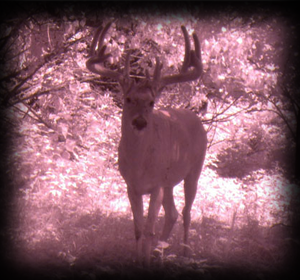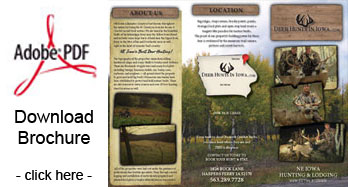Welcome to Deer Hunts In Iowa
 Northeast Iowa, along the Mississippi River corridor, has been producing some of the country’s highest concentrations of recordbook whitetails for decades. Allamakee County located in the far NE corner of the state, is ranked as the #1 trophy-producing county in Iowa and #3 in the entire nation. There are several reasons for this.
Northeast Iowa, along the Mississippi River corridor, has been producing some of the country’s highest concentrations of recordbook whitetails for decades. Allamakee County located in the far NE corner of the state, is ranked as the #1 trophy-producing county in Iowa and #3 in the entire nation. There are several reasons for this.
Annual floods saturate the fertile soil each year with a high concentration of minerals important to whitetail antler growth and higher body weights. The plants uptake these minerals then passed on to the deer when ingested. These Mississippi river-bottom floodplains contain some of the best quality soil not only for growing good crops but also huge racks.
 The rugged and steep terrain with big continuous blocks of timber and large sections of land with few roads in between allow for the deer herds to reach a better age structure. Big bucks have an easier time staying out of sight, evading hunters, and ultimately get to be old. Because of the billy goat style terrain, hunters have a harder time penetrating and getting at them, even in the public hunting areas. Winter blizzards and rough weather are also easier to handle as these deer use the steep cedar choked bluffs to block the wind, trap their thermal heat, and even warm themselves during the cold winter days on South facing slopes.
The rugged and steep terrain with big continuous blocks of timber and large sections of land with few roads in between allow for the deer herds to reach a better age structure. Big bucks have an easier time staying out of sight, evading hunters, and ultimately get to be old. Because of the billy goat style terrain, hunters have a harder time penetrating and getting at them, even in the public hunting areas. Winter blizzards and rough weather are also easier to handle as these deer use the steep cedar choked bluffs to block the wind, trap their thermal heat, and even warm themselves during the cold winter days on South facing slopes.
As a general rule of thumb, the further North you go the bigger the live weight of a deer. Being in the far North East corner of the state with the steep bluffs and large blocks of timber, big bucks have to travel further during the rut, allowing the best genetics to be passed on. The arduous climbing these big bucks do on a daily basis not only packs on more muscle but also ensures the biggest, strongest, and most physically fit pass their genes along.
The diversity of forage also play a role in antler development and higher body weight. Like the rest of Iowa and the Midwest in general, there is a lot of corn and soybeans grown here. However, there is a high concentration of local Dairy Farms in NE Iowa along with very strict soil conservation programs to protect against erosion in the hilly fields. To stay in line with the Soil Conservation mandates, farmers plant strips and rotate high protein Alfalfa, oats, winter wheat, and rye with their cash crops of corn and soybeans. This ultimately creates a smorgasbord of quality feed and nutrition for the deer herds year round.
Bucks are most active during the month of November with the rut. This is also a time when they are the most vulnerable. The Iowa gun season doesn’t start until December after the rut is mostly over. This too helps with the overall age structure allowing many big bucks to survive as they hole-up in some of the thicker areas with less access and return to more restricted travel with nocturnal feeding patterns.
These are just a few of the reasons to consider a hunt of a lifetime in Allamakee County’s Zone 9 and Deer Hunts In Iowa.
Contact us today to book your hunt with us.
Like Us on Facebook





